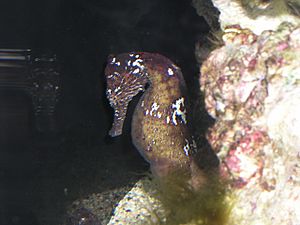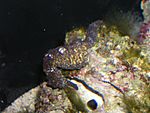Hippocampus kuda facts for kids
Quick facts for kids Hippocampus kuda |
|
|---|---|
 |
|
| Conservation status | |
| Scientific classification | |
| Synonyms | |
|
Hippocampus kuda, also known as the common seahorse, estuary seahorse, yellow seahorse or spotted seahorse is a seahorse of the family Syngnathidae native to the Indo-Pacific. The common name sea pony has been used for this species under its synonym Hippocampus fuscus.
Contents
Description
The yellow seahorse is a small fish that can reach a length of 17–30 cm.
The body is quite large, elongated and has no spines, all bumps are rounded. The head is relatively large compared to the body. The snout is short and thick. The coronet is small and rises towards the rear, it can also sometimes have more or less long filaments. Some adults have a black line running through the dorsal fin in the direction of its width. The body coloration is often dark with a grainy texture but can also be yellow, cream or reddish with blotches and numerous small dark spots.
Distribution and habitat
The yellow seahorse inhabits waters from the Persian Gulf to Southeast Asia, Australia, Japan, and several Pacific islands including Hawaii, and is also found the eastern coast of Africa from Tanzania to South Africa. Under its synonym Hippocampus fuscus it has been recorded in the Mediterranean Sea having colonised from the Red Sea as a Lessepsian migrant.
It inhabits both benthic habitat in coastal waters with soft or rocky bottom, sheltered waters of estuaries, harbors or mangroves, and open pelagic waters, where it clings to drifting Sargassum seaweed. It occurs from the surface to 8 m deep, with a maximum observed depth observed of 55 m.
Biology
The yellow seahorse has a carnivorous diet and feeds on small crustaceans and other planktonic organisms.
It is ovoviviparous and it is the male who broods the eggs in its ventral brood pouch. The latter includes villi rich in capillaries that surround each fertilized egg creating a sort of placenta supplying the embryos. The young (called pups) exit the pouch once fully grown, and from then on live autonomously.
Conservation status
The species is still commonly encountered (especially in Indonesia and New Guinea) but is currently classified as vulnerable by the IUCN, as populations face some threat from bycatch in the shrimp trawl fishery, targeted catch for the aquarium and traditional medicine trade, and habitat destruction, coupled with low fecundity due to the involved method of parental brood care. Internationally, it is also listed in Appendix II of the Convention on International Trade in Endangered Species of Wild Fauna and Flora (CITES) this means that it is on the list of species not necessarily threatened with extinction, but in which trade must be controlled in order to avoid utilization incompatible with their survival.
In the aquarium
Common seahorses have very small mouths, eating only small animals like brine shrimp and even newborn guppies. Seahorses need to eat a lot — 4–5 times a day. Many aquarists who have kept this species cultivate their own brine shrimp and rotifers. Daphnia is eaten when other foods are unavailable.
Seahorses spend most of their time anchoring to coral reefs and branches with their tails, necessary because they are poor swimmers. They therefore need similar anchor points in aquaria. Seahorses like a quiet tank, without large, belligerent fish, and a slow-moving current. Aquarists have found them to be generally accepting of tankmates like Synchiropus splendidus and other bottom-dwelling fishes.
Temperature, pH, and salinity
Common seahorses generally do best at a temperature of 72–77 °F (22–25 °C), optimally 73–75 °F (23–24 °C). They do not tolerate even spikes above 80 °F (27 °C) well. Their optimal pH range is around 8.1–8.4. The common seahorse can tolerate a range of salinity from 18 parts per thousand (ppt) to 36 ppt but salinity below about 25ppt should be promptly corrected. About 32 ppt is ideal.
Images for kids
See also
 In Spanish: Hippocampus kuda para niños
In Spanish: Hippocampus kuda para niños




